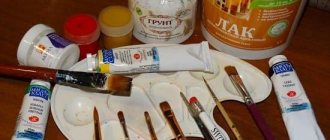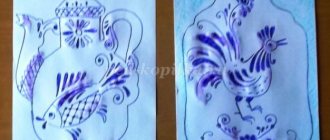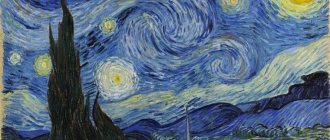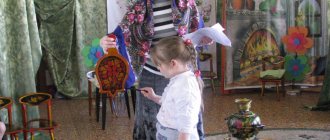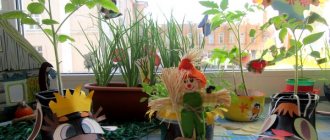Where to start? With preparation!
Gzhel is a whole direction of Russian culture. Gzhel painting is done on a white background with blue, light blue, azure colors, and paints of other shades. It is unlikely that anyone has not seen objects painted using this wonderful technique. Even if someone has not seen it, you can get an idea by looking at this wonderful dish. Can you imagine how it will decorate the table, turning it from ordinary to festive?
Please note: all drawings using the Gzhel technique consist of brush strokes. A special Gzhel (double) stroke is applied from the wide part to the narrow part. First, use the flat side of the brush, then turn the brush slightly and paint with the narrow part. This can be clearly seen in the video, where masters show how they paint an object. There are many such recordings on YouTube.
To teach children, you first have to master the technique yourself. An art album on Gzhel according to the Federal State Educational Standard will be very helpful with this. The value of the publication is that it describes the drawing process step by step and shows it in pictures. He also tells how to teach children the features of strokes and the sequence of painting. There are also practical tasks for studying the elements of painting in the album “Rossinochka” based on Gzhel. The manuals have different authors, but both are good from a practical point of view.
METHOD FOR MANUFACTURING GZHEL FISH PRODUCTS
Painting: fairytale Gzhel
Creating products for Gzhel requires from the master extraordinary precision, painstakingness and an incredible flight of imagination. The dishes can be made of porcelain or majolica. The difference is that porcelain is white clay. It is more fragile and thin. Majolica is made from red clay and is more durable.
The entire manufacturing process can be divided into five stages:
• Creation of a blank • Preparation for painting and first firing • Control and rejection of products • Painting • Second firing
Procurement process:
- The preparation process involves creating a porcelain or majolica mold from clay according to the artist’s sketches. This preparation is made on a pottery wheel, but not with your hands, but with special tongs. After the plaster mold is ready, liquid porcelain mass is poured into it, which gradually hardens. Gypsum absorbs moisture well, so porcelain hardens quickly.
- The next stage is preparation for painting. It includes polishing the product and firing it. Firing lasts about eight hours.
- After firing, it is necessary to monitor the quality of the product and the presence of defects in it. If the defect cannot be eliminated, the product is sent to scrap and melted down.
- After this, painting begins. Each master has his own unique method of applying patterns and signs his work at the end. Then, the supporting parts of the product are treated with paraffin. To do this, the master manually dips the dishes into a bath of hot paraffin. Then, the product is dipped in glaze and sent for a second firing. It lasts quite a long time, eighteen hours. It is thanks to underglaze painting that the color saturation remains the same for a long time.
- Thus, each stage of the work is performed manually. Such work is very painstaking, therefore, mostly women work in Gzhel factories.
What will you need for work?
- Paints are white and blue, shades of blue. For the first time, white and blue are enough. For painting you can use gouache, watercolor, acrylic.
- Brushes. Paint with flat synthetic brushes of different numbers. You can try No. 7, which gives a fairly large smear. Thin brushes are suitable for painting blades of grass and other elements.
- Stencils on which children will practice and perfect their strokes before painting dishes. They can be found on the Internet and printed, or taken from special publications. Wooden stencils work well - for example, this teapot. On the one hand, you can paint it according to the applied design, on the other, you can paint it yourself.
- Ceramic, clay, wooden or plastic tableware (plates, cups, saucers).
- Jars for water, simple oilcloth, paint removal wipes, clothing protection, etc.
Popular message topics
- The water cycle in nature A lot of time has passed since the planet on which we live was formed. But the total number of waters on it, one might say, remained unchanged. But since water is constantly moving on the earth's surface
- Predators and their prey Animals and birds that feed on the meat of other animals or their own kind are called predators or carnivores. Currently, this category is conventionally divided into two main species - land animals and pinnipeds. There are about 300 species worldwide
- Aphrodite Aphrodite is known to us from ancient Greek myths and legends. She is one of the great goddesses of Olympus. She is the daughter of Zeus and Dione, according to legend, born from sea foam.
Gzhel painting: features, types of Gzhel painting, colors and elements
How to draw using the Gzhel technique in the senior group?
Each professional master class of a Gzhel specialist involves at least several classes. We will also focus on this and learn step by step. I can suggest something like this:
- A story about Gzhel - a painting technique, a type of craft and art. Display visual materials to interest children. These can be pictures or objects, preferably funny and eye-catching. For example, like these piglets (by the way, they can really be used on the farm). Stroke practice on paper.
- Stencil painting (coloring), elaboration of the ornament, fixing the stroke. We learn to confidently draw a drop, a blade of grass, a curl, a spiral, a wavy line. The stencil can be on a regular sheet or cut out in the shape of a jug, teapot, or cup. It is better to use gouache.
- Painting of tableware. The ideal option is to draw a traditional Gzhel rose with variations. Children will both learn and learn the name. Acrylic paints will perform better. It is difficult to draw on a convex or concave workpiece, especially for the first time; you will need the help of an adult.
Variations are possible in any of the points. You can make the blank with your own hands - for example, mold flat medallions-“plates” with a diameter of about 8-10 cm from clay, dry it, paint it with white paint, apply a pattern with a pencil (blue felt-tip pen) and paint it. Here's a souvenir for March 8 or grandma's birthday! You can draw on plastic or other disposable utensils; such “blanks” are inexpensive and do not require labor to prepare.
Under Gzhel, you can paint templates in the form of eggs for Easter, postcards. Or you can buy white cups for painting, give them to children to paint, and then cover them with a special varnish and give them to families. Can you imagine what a memory this will be for years to come?
Color scheme of Gzhel painting
Gzhel painting was initially done exclusively with blue paint (shades are allowed). It is this feature of this art form that makes it difficult for beginners to perform even in this day and age. Not every artist can create a beautiful drawing using a limited number of colors.
The main colors used by masters in Gzhel painting are:
- snow-white color (always used as a background shade, since it does not set off the contrasting paint with which the main ornament is created);
- all shades of blue, the most popular of which are deep blue and pale blue;
- cobalt color (dark shade);
- white paint color (used for mirror painting, when the ornament is created on a blue background - on the contrary, in comparison with classical Gzhel painting);
- gold (a modern innovation by artists who, using a noble shade of gold, strive to place accents on a hand-created image);
- platinum (rarely used, also to focus the viewer’s attention on specific details of the ornament).
History of the fishery
What is Gzhel? This is a type of Russian folk painting, recognizable far beyond the borders of Russia. The word gzhel is known not only by art critics and artists. If you ask a foreigner to create an initiative series for the word “Russian, Russia,” then you definitely won’t be able to do without traditional Khokhloma and Gzhel. Gzhel is the name given to a vast region near Moscow, uniting 27 villages. They are usually called “Gzhel bush”. Geographically, it is located 60 km from Moscow along the Moscow-Murom-Kazan railway line. Now this is the Ramensky district of the Moscow region, previously the territory belonged to the Bogorodsky and Bronnitsky districts.
Pottery has been developing here for a long time, and since the mid-17th century, valuable varieties of clay have been mined in Gzhel. Then the natural material was used for pharmaceutical needs, or, to be more precise, “for alchemical utensils.” Until the mid-18th century, Gzhel produced the usual products of that time - dishes, bricks, pottery pipes, tiles, and also children's toys. But at the equator of the century, Gzhel became the most powerful center for the production of majolica in Russia. Even Mikhailo Lomonosov wrote about the unique whiteness of Gzhel clay.
Then the production of semi-faience and earthenware was established in this area, as a result of which a porcelain factory was founded. In the second quarter of the 19th century, Gzhel art reached its peak. The description of the best works made in this technique dates back to this period. And then there was a recession caused by industrial reform in Russia, and a long lull. Only after the Great Patriotic War, thanks to the ascetic masters, Gzhel, as a folk painting, was revived.
Read more about the history of Gzhel in our article: History of Gzhel: from the origin of the fishery to the present day
The history of the emergence of Gzhel patterns and ornaments
Gzhel (painting for children can be done with ordinary paints on any surface) is the name of one of the regions of the Moscow region. Initially, several villages and towns were geographically located in this area, the inhabitants of which were masters of pottery art. That is why the first Gzhel paintings were applied to clay mined in the specified area. The first mention of this type of fine art dates back to the 14th century (approximately 1328).
Its distinctive characteristic is the limited use of colors (1 shade on a snow-white background)
The development of folk crafts was greatly influenced by consumer demand, since Gzhel residents fed their families with the money received from the sale of painted dishes. Gzhel painting reached the peak of its development and popularity in the 18th century, when it began to be used to decorate not only dishes and decorative items for residential premises, but also toys, figurines and memorable souvenirs
During this period, painting began to be applied mainly to porcelain and earthenware.
At the beginning of the 20th century, there was restraint in the development of the Gzhel fishery. This is due to the suppression of factory production due to the nationalization of enterprises by the Soviet government. The active restoration of this type of artistic art begins to gain popularity again only from the end of the 20th century.
Gzhel patterns
In past times, Gzhel potters gave preference to the surrounding world in painting, combining nature, city and village life, architecture and iconography in their drawings, and the finishing touch was their own imagination. Today, the theme of Gzhel drawing can be divided into three types: plant (image of cereals, berries, twigs and blades of grass, flowers), plot (nature and seasons) and ornamental (the main preference is given to “checkered” patterns - rows of blue and white squares in side). Gzhel painting technology allows you to create unique and amazing things.
Color scheme of Gzhel painting
Gzhel painting was initially done exclusively with blue paint (shades are allowed). It is this feature of this art form that makes it difficult for beginners to perform even in this day and age. Not every artist can create a beautiful drawing using a limited number of colors.
The main colors used by masters in Gzhel painting are:
- snow-white color (always used as a background shade, since it does not set off the contrasting paint with which the main ornament is created);
- all shades of blue, the most popular of which are deep blue and pale blue;
- cobalt color (dark shade);
- white paint color (used for mirror painting, when the ornament is created on a blue background - on the contrary, in comparison with classical Gzhel painting);
- gold (a modern innovation by artists who, using a noble shade of gold, strive to place accents on a hand-created image);
- platinum (rarely used, also to focus the viewer’s attention on specific details of the ornament).
Traditional painting
And yet, blue and white Gzhel is recognized as traditional. It’s not for nothing that she was nicknamed “The Blue of Russia.” The drawing is made with a special paint composition based on cobalt oxide using a brush stroke.
Teapot with gold
The painted product is dipped into white glaze and fired in a kiln at a temperature of about 1400°C. After firing, the glaze becomes transparent, the product acquires a glossy shine and hardness, and the design appears in all its glory, playing with shades of color from soft blue to deep blue.
Service, Gzhel porcelain factory
Sometimes, on top of the already fired glaze, a fine decoration with gold or platinum is applied to the cobalt design and the product is fired again in the kiln.
Features of Gzhel painting
Gzhel painting is easy to recognize among other styles. Her signature style is blue and light blue patterns on a dazzling white background.
Cobalt is used as paint to apply the design. It acquires its characteristic blue color during the firing process.
The images use geometric belts, floral patterns and floral patterns. On large products you can find entire landscapes and architectural structures, as well as conventional images of figures of people and animals.
Hedgehog, cow and horse.
The design on ceramic products is applied manually using a brush. This allows cobalt oxide to create images with many shades: from deep dark blue to delicate blue.
Popular Gzhel
This type of Gzhel painting was widespread in the 18th century. appeared when many craftsmen began to undergo training at the Grebenshchikov plant in Moscow. All dishes were painted with ornaments made in green, yellow, blue and violet-brown paints on a white background. They usually depicted pictures in the style of the then fashionable popular print. Often it was a bird in the center of the picture, a house, and later people and animals. Now this painting is lost.
Jugs, popular Gzhel
Overglaze Gzhel
The most beautiful type of Gzhel painting, it is also the most ancient. This is painting with colored paints that are applied over the glaze. This technique is particularly complex and very labor-intensive. Such products undergo three and sometimes four firings.
Dish
From the website of the Gzhel Porcelain Factory
Tea couple
Such Gzhel dishes are quite expensive, but they look as if they were “from a palace”.
Blind cobalt
An amazing effect when you look at such Gzhel painting. It seems that this is a “mirror reflection” of the usual white and blue Gzhel. Cobalt covers the entire surface of the product, then glaze is applied. After firing, the design is applied with white paint and gold.
Vases, cobalt
White and bone china
Gzhel porcelain is of very high quality. Even Peter I and Lomonosov admired its whiteness. Therefore, the Gzhel factory produces pure white dishes or applies a delicate gold pattern to it. This makes her seem even whiter.
Service "Peony"
Cafes and restaurants in Gzhel
There are few catering establishments in Gzhel itself, but travelers will not go hungry. There is a station cafe right at the railway station. In addition, if you go to Gzhel on an excursion, then the Sin Rossii factory will probably be one of the points on your route. And there will be a tea party with bagels (a mandatory element of the program), and a small cafe where you can have a delicious lunch.
In general, in the depths of settlements, catering establishments are not found as often as we would like. But along the Yegoryevskoye Highway, into which the Central Street of Gzhel passes, you can find a large number of roadside cafes and small restaurants. This is, for example, the cafe “Seven Fridays” in the village of Novo-Kharitonovo or “Sunflower” in the village of Elektroizolyator. And on the 10th km of Yegoryevskoye Highway, right on the shore of the lake, there is a small restaurant with the simple name “By the Lake”. Here travelers can eat Russian cuisine and, if desired, also go fishing, practically without leaving the table.
Progress of the lesson:
The land of the porcelain miracle,
And all around him are forests...
Blue-eyed dishes -
Vases, teapots and dishes
It shines brightly from there,
Like native heavens!
It is with this beautiful, gentle poem that I want to start our lesson.
So. In a certain kingdom, in the Russian state, not far from Moscow, among forests and fields stands the town of Gzhel.
Once upon a time - long ago - there lived brave and skillful, cheerful and beautiful craftsmen. They got together one day and began to think about how best they could show their skills, please all the people and glorify their land. They thought and thought and came up with something. They found wonderful clay in their native side, white - white, and decided to sculpt from it
different dishes, and such as the world has never seen. Each master began to show his ability. He made one teapot, another master looked and did not make a teapot, but made a jug, and the third a dish. Each master began to sculpt his own dishes, and there was not a single product similar to another. But Gzhel craftsmen decorated their products not only with stucco molding; they painted dishes with blue paint of different shades. They painted various patterns of nets, stripes, and flowers on the dishes. The painting was very intricate and elegant. People fell in love with the beautiful dishes and began to call them “pale blue miracles”
. The masters glorified their beloved land throughout the world; they told everyone what skilled craftsmen live in Rus'.
Today we will visit the exhibition of Gzhel ceramics.
Look and tell me, please, what objects were painted by the Gzhel masters? What elements of painting did they use to decorate their products? (flowers, grass, leaves, curls, branches)
. What primary colors do craftsmen use in their products?
And now I want to invite you to become Gzhel masters.
Let's all sit down at our tables. And we will paint the jug. Look how I painted the jug. What elements are used in painting the teapot? And now I will show you in what order to draw these elements. Let's start drawing with a trefoil flower. We paint the petal along the edge from left to right with continuous lines without gaps. We work with blue paint. Now let the flower dry, and with the end of the brush we will draw a branch, grass, curls along the upper and lower edges. You know this, and I won’t show it. We work with such paints like real masters. To do this, take the end of the brush with dark blue paint and draw a thin line along the edge of the flower.
Children's independent work is performed to the sound of Russian instruments.
The teacher conducts individual work. At the end of the work, the children organize an exhibition of their works and analyze them.
These are the jugs the children made.
Gzhel painting: basics of technology
All the beauty of this design is achieved through mixing 2 colors, which allows you to get a large number of shades between pure royal blue and dazzling white. At the same time, the technology involves both contrasting transitions, stretching through shading, and even almost complete darkening of blue to black. All this is done by changing brushes, pre-mixing shades, and even combining them on the pile at the same time.
- The difficulty of Gzhel painting is mastering brush movements. The width and density of the stroke, the thickness of the paint layer on each part of the pile, its direction - there are no minor nuances here. Therefore, all beginners need to first work out the basic elements, where gradually, step by step, new and new techniques are added.
- The “cut-off spot” also plays a significant role. If you analyze the drawings made using this technology, you will notice that the shades are arranged in the composition according to a certain pattern. This is an almost smooth transition from a clean, light spot (which is the center of the picture), to dark edges, towards which the saturation and depth of color intensify. The opposite option is also quite possible, when small details along the edges disappear into an illuminated haze, and large central elements, on the contrary, are dark and dense.
It is important to remember that the elements of Gzhel painting are always accompanied by smoothness, softness, roundness of lines, ease of shade transitions, even if they have a contrasting joint (there will always be a slight stretch in it), small details along the edge
Inspiring and being inspired in class
How to inspire a child to work? It’s fun to tell and show a finished decorative product. For example, such a wonderful tray. Using it you can study different elements of painting - roses, leaves, blades of grass, borders and other motifs.
After drying, the “plates” need to be laid out on the exhibition stand. Of course, in the end they will be far from the proposed sketch, and the stroke is unlikely to turn out perfect. Their value is that the child learns new things, and he needs to be taught not to be afraid to use his skills. That is, do not criticize under any circumstances, and especially not make fun of them. It is also very valuable when a child in later life encounters Gzhel painting, recognizes it and knows the name.
What are the benefits of such drawing for children? Gzhel classes:
- give an understanding of art and its types, arouse interest in it;
- introduce children to Russian culture;
- teach you how to make beauty with your own hands;
- give practical skills in painting;
- form persistence, diligence and the desire to complete the task;
- develop aesthetic taste;
- improve fine motor skills.
But most importantly, painting allows you to reveal the creative and artistic abilities of a child and develop a craving for creativity. It is not necessarily Gzhel that will touch the strings of a child’s soul. It could be Khokhloma, Gorodets painting. There are rhymes for children on the theme of almost every folk craft. Sometimes it’s these things that captivate kids, sometimes it’s the exciting history or geography of art. Let me put it another way and say that the paths of art are inscrutable, and our task is to unobtrusively show them.
Colors of Gzhel painting
There are several opinions as to why blue patterns on a white background became the most successful for Gzhel ceramists. Even a child can recognize the bluish swirls on the milky whiteness of the porcelain. But, as already mentioned, there are several types of painting, where the color palette was not so limited.
Both versions are plausible, and mixing them may be true. The blue color paired best with the glaze. Other colors did not always give a good combination, and many products had to be rejected. Blue “worked” perfectly. It is also true that painting in blue and white colors was a worldwide trend at that time: the famous Dutch tiles and Chinese porcelain are vivid examples of this.
Both technical tricks and cultural borrowing took part in the creation of a global artistic brand. Modern designers constantly play with Gzhel color schemes in their works. They decorate their interiors with Gzhel-style textiles and use Gzhel-inspired wall decoration. And, surprisingly, the blue and white Russian aesthetic manages to coexist perfectly in country, Scandinavian style, and even in Provence.
Mixing two colors makes it possible to obtain many shades. The master uses contrasting transitions, stretching through shading, and even strong darkening of blue.




